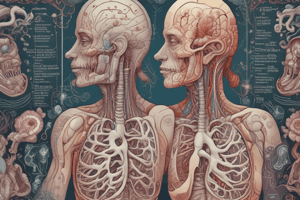Podcast
Questions and Answers
What part of the respiratory passageway primarily functions to warm, humidify, and filter inhaled air?
What part of the respiratory passageway primarily functions to warm, humidify, and filter inhaled air?
- nasopharynx
- larynx
- trachea
- nasal cavity (correct)
Where are alveoli found?
Where are alveoli found?
- bronchioles
- conducting zone
- in the lungs (correct)
- pleural cavity
What coats the surface of the respiratory membrane?
What coats the surface of the respiratory membrane?
- pleural fluid
- simple, squamous epithelium
- surfactant (correct)
- alveolar macrophages
What term is used for the movement of oxygen into the blood and carbon dioxide toward the air?
What term is used for the movement of oxygen into the blood and carbon dioxide toward the air?
What is the pressure in the lungs when inspiration is occurring?
What is the pressure in the lungs when inspiration is occurring?
What is the role of bicarbonate in gas transport?
What is the role of bicarbonate in gas transport?
Where are breathing control centers located?
Where are breathing control centers located?
Which of these will lower blood pH beyond the normal range?
Which of these will lower blood pH beyond the normal range?
What respiratory disorder is characterized by enlarged alveoli and pulmonary fibrosis?
What respiratory disorder is characterized by enlarged alveoli and pulmonary fibrosis?
Which of these organs of the respiratory system is located in the neck?
Which of these organs of the respiratory system is located in the neck?
Which of these removes tiny dust particles from alveolar surfaces?
Which of these removes tiny dust particles from alveolar surfaces?
What keeps the visceral and parietal pleural membranes in contact with each other?
What keeps the visceral and parietal pleural membranes in contact with each other?
How does air flow between neighboring alveoli?
How does air flow between neighboring alveoli?
Identify the trachea of the respiratory system.
Identify the trachea of the respiratory system.
What function do the paranasal sinuses serve?
What function do the paranasal sinuses serve?
Which of the following is part of the respiratory zone?
Which of the following is part of the respiratory zone?
Which of the following is made by the cuboidal alveolar cells to lower surface tension and prevent lung collapse?
Which of the following is made by the cuboidal alveolar cells to lower surface tension and prevent lung collapse?
Flashcards are hidden until you start studying
Study Notes
Respiratory Passageways
- The nasal cavity is responsible for warming, humidifying, and filtering inhaled air as it enters the body.
Alveoli
- Alveoli are located in the lungs and serve as the primary site for gas exchange, composed of air sacs.
Respiratory Membrane
- The surface of the respiratory membrane is coated with surfactant, a lipoprotein that reduces surface tension in the alveoli, preventing lung collapse.
Gas Exchange Mechanics
- External respiration refers to the process of oxygen moving from alveolar air into the blood and carbon dioxide moving from blood into the alveolus.
Pressure Dynamics During Breathing
- During inspiration, lung pressure is lower than atmospheric pressure, allowing air to flow into the lungs as thoracic cavity volume increases.
Role of Bicarbonate
- Bicarbonate is crucial for transporting the majority of carbon dioxide in the blood as it enhances solubility compared to carbon dioxide alone.
Breathing Control Centers
- The pons and medulla in the brain stem regulate breathing patterns and control centers.
Effects of Apnea
- Apnea, or cessation of breathing, leads to increased carbon dioxide levels in the blood, resulting in elevated carbonic acid and decreased blood pH.
Respiratory Disorders
- Emphysema is characterized by enlarged alveoli and fibrosis, leading to compromised lung elasticity and function.
Larynx
- The larynx is situated in the neck and plays a critical role in air passage and voice production.
Dust Particle Removal
- Macrophages are responsible for clearing tiny dust particles from the alveolar surfaces, maintaining respiratory health.
Pleural Membranes
- Pleural fluid keeps the visceral and parietal pleural membranes adhered to each other, facilitating lung movement during respiration.
Airflow Between Alveoli
- Alveolar pores allow air to flow between neighboring alveoli, enabling efficient gas exchange.
Trachea
- The trachea (windpipe) extends approximately four inches from the larynx down to the midchest, connecting the upper airway to the lungs.
Paranasal Sinuses
- The paranasal sinuses produce mucus, lighten the skull, and serve as resonance chambers for sound production in speech.
Respiratory Zone
- Alveoli are designated as part of the respiratory zone, essential for gas exchange during respiration.
Function of Surfactant
- Surfactant is produced by cuboidal alveolar cells to lower surface tension and prevent alveolar collapse, especially important after birth.
Oxygen Diffusion
- Oxygen diffuses from air into the blood primarily through the process of external respiration during gas exchange at the alveoli.
Studying That Suits You
Use AI to generate personalized quizzes and flashcards to suit your learning preferences.



